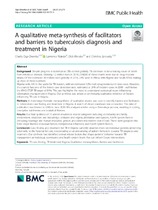| dc.contributor.author | Zarowsky, C | |
| dc.contributor.author | Oga-Omenka, C | |
| dc.contributor.author | Wakdet, L | |
| dc.date.accessioned | 2021-04-15T07:10:01Z | |
| dc.date.available | 2021-04-15T07:10:01Z | |
| dc.date.issued | 2021 | |
| dc.identifier.citation | Zarowsky, C. et a. (2021). A qualitative meta-synthesis of facilitators and barriers to tuberculosis diagnosis and treatment in Nigeria. BMC Public Health,21(1),279 | en_US |
| dc.identifier.issn | 1471-2458 | |
| dc.identifier.uri | https://doi.org/10.1186/s12889-021-10173-5 | |
| dc.identifier.uri | http://hdl.handle.net/10566/6029 | |
| dc.description.abstract | : Despite progress in tuberculosis (TB) control globally, TB continues to be a leading cause of death
from infectious diseases, claiming 1.2 million lives in 2018; 214,000 of these deaths were due to drug resistant
strains. Of the estimated 10 million cases globally in 2018, 24% were in Africa, with Nigeria and South Africa making
up most of these numbers.
Nigeria ranks 6th in the world for TB burden, with an estimated 4.3% multi-drug resistance in new cases. However,
the country had one of the lowest case detection rates, estimated at 24% of incident cases in 2018 - well below
the WHO STOP TB target of 84%. This rate highlights the need to understand contextual issues influencing
tuberculosis management in Nigeria. Our synthesis was aimed at synthesizing qualitative evidence on factors
influencing TB care in Nigeria. | en_US |
| dc.language.iso | en | en_US |
| dc.publisher | Springer Nature | en_US |
| dc.subject | TB case finding | en_US |
| dc.subject | TB treatment | en_US |
| dc.subject | Nigeria | en_US |
| dc.subject | Qualitative meta-synthesis | en_US |
| dc.subject | Barriers and facilitators | en_US |
| dc.title | A qualitative meta-synthesis of facilitators and barriers to tuberculosis diagnosis and treatment in Nigeria | en_US |
| dc.type | Article | en_US |

